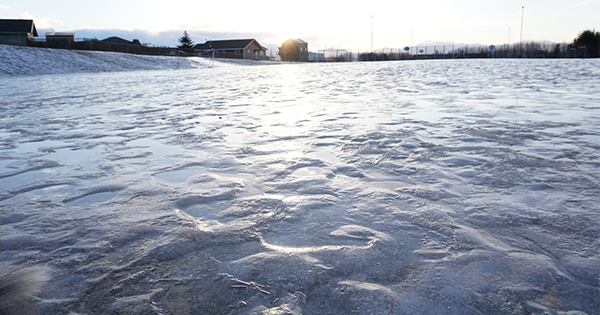
A series of storms blew out the old year in southcentral Alaska. Winds reaching 91 mph flung a semi right off the highway between here and Anchorage. Another gust tipped a second truck not far away. Our neighbor’s roof shingles ended up in our backyard. Power was knocked out in homes across town and in a tiny Native village on the other side of the bay. The school over there, which serves all ages, closed out the semester with the lights of someone’s truck shining into the windows so that students and teachers could see in the dark. The village goes by the Russian Orthodox calendar, which marks Christmas on January 7. Their winter break began the day my daughters returned to school.
The storms brought warm wet weather to this part of Alaska. And everyone is sick about it. Rain melted the snow from our favorite sledding hill and turned the ski trails mushy. When it first warmed up, sleet glazed the town in a sheet of ice. Now the ice is gone. But with the blanket of white gone too, it’s dark and dismal. We all wonder whether we’ll see snow again this winter.
Last Sunday, I had a story in the Sunday magazine of the state’s largest newspaper—the Alaska Dispatch News—about the future of snow in Alaska. The future is grim. Over the past five and a half decades, the average annual temperature in Alaska has increased 3.1 degrees Fahrenheit. But winters here have warmed far more over that time— by 5.7 degrees—meaning more rain, less snow, even as far north as the Arctic.
People think that warming winters make life easier in Alaska—breaking us free of our frigid months—but the opposite is true. It’s winter rain rather than snow that cancels schools here, that transforms our highways into deadly rinks, and that ruins the snowpack on which so many of us love to ski, snowmobile, and sled. And winter rain wreaks havoc on the ecosystem.
Snow is the blanket that insulates the natural world from much of the harshness of northern winters. Small mammals such as mice and voles tunnel under the snow where the temperatures are relatively balmy and they can access the plants they feed on. These animals are at the bottom of the winter food chain, turning vegetation buried deep under the snow into furry calories on which fox, coyote, lynx, and other animals depend. When rain comes in the winter, it can lacquer the snow in a layer of ice so thick no animal can get through.
In the course of reporting my story, I spoke with Jim Dau, a caribou biologist for the state who focuses on the Western Arctic herd. He credits rain falling on snow with jump-starting a population decline in the species. The rain melts the snow into a hardpan of ice that seals off the low-growing vegetation on which the animals depend.
There was no good news. Before the New Year, between storms, I drove my daughters to our favorite sledding hill, where we’d had a birthday party for my six-year-old a few weeks earlier. The hill, which still had patches of snow and ice between expanses of grass, rose above the local elementary school’s playing field, which was covered in three inches of ice. It was midway through winter break, and the field and nearby playground were empty and still. With the vacant playground in the background, and sun illuminating every icy contour, the scene looked like the picture of a grim future to me.
My girls didn’t seem to mind. They managed to inch their way up the sledding hill half a dozen times and zip down on their snow pants.

